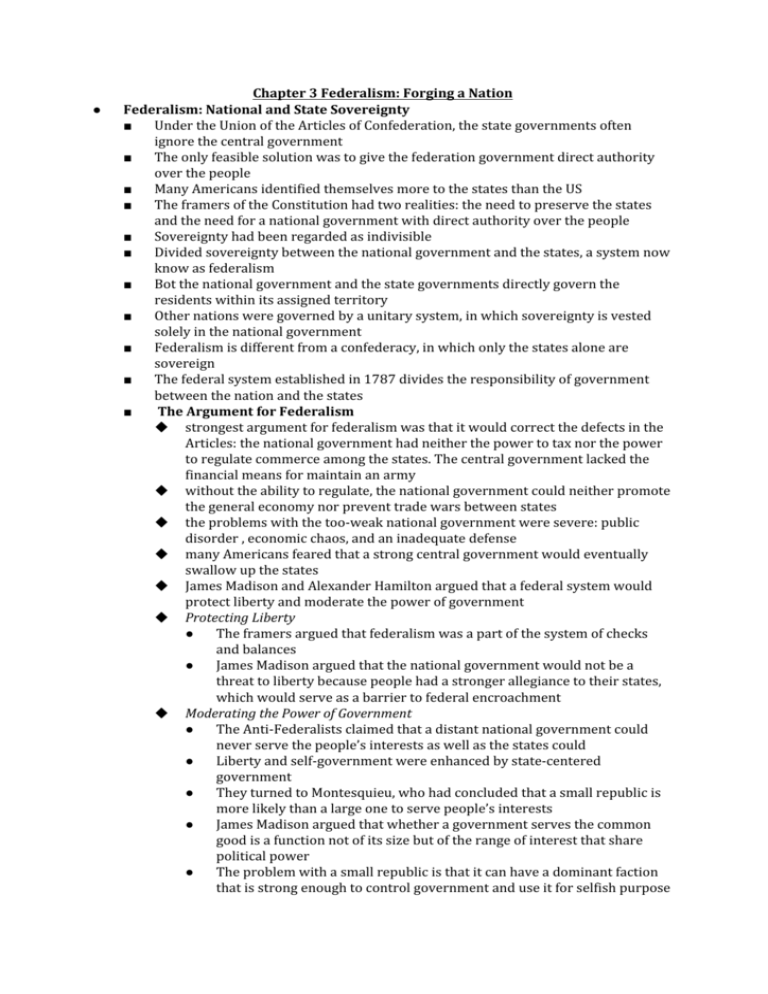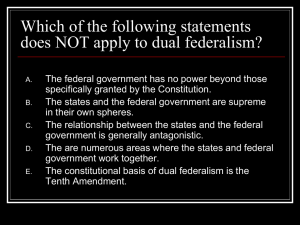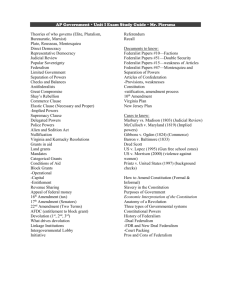Chapter 3 Federalism: Forging a Nation Federalism: National and
advertisement

● Chapter 3 Federalism: Forging a Nation Federalism: National and State Sovereignty ■ Under the Union of the Articles of Confederation, the state governments often ignore the central government ■ The only feasible solution was to give the federation government direct authority over the people ■ Many Americans identified themselves more to the states than the US ■ The framers of the Constitution had two realities: the need to preserve the states and the need for a national government with direct authority over the people ■ Sovereignty had been regarded as indivisible ■ Divided sovereignty between the national government and the states, a system now know as federalism ■ Bot the national government and the state governments directly govern the residents within its assigned territory ■ Other nations were governed by a unitary system, in which sovereignty is vested solely in the national government ■ Federalism is different from a confederacy, in which only the states alone are sovereign ■ The federal system established in 1787 divides the responsibility of government between the nation and the states ■ The Argument for Federalism ◆ strongest argument for federalism was that it would correct the defects in the Articles: the national government had neither the power to tax nor the power to regulate commerce among the states. The central government lacked the financial means for maintain an army ◆ without the ability to regulate, the national government could neither promote the general economy nor prevent trade wars between states ◆ the problems with the too-weak national government were severe: public disorder , economic chaos, and an inadequate defense ◆ many Americans feared that a strong central government would eventually swallow up the states ◆ James Madison and Alexander Hamilton argued that a federal system would protect liberty and moderate the power of government ◆ Protecting Liberty ● The framers argued that federalism was a part of the system of checks and balances ● James Madison argued that the national government would not be a threat to liberty because people had a stronger allegiance to their states, which would serve as a barrier to federal encroachment ◆ Moderating the Power of Government ● The Anti-Federalists claimed that a distant national government could never serve the people’s interests as well as the states could ● Liberty and self-government were enhanced by state-centered government ● They turned to Montesquieu, who had concluded that a small republic is more likely than a large one to serve people’s interests ● James Madison argued that whether a government serves the common good is a function not of its size but of the range of interest that share political power ● The problem with a small republic is that it can have a dominant faction that is strong enough to control government and use it for selfish purpose ● ● ● A large republic is less likely to have an all-powerful faction Madison argues that a large republic would make it difficult for a single group to gain full control, which would force groups to share in the exercise of power ■ The Powers of the Nation and the States ◆ US Constitution addresses the lawful authority of the national government ◆ Authority that is not granted to the national government is left—or “reserved”—to the states ◆ Enumerated Powers and the Supremacy Clause ● Article I of the Constitution grants the Congress seventeen enumerated (expressed) powers ● Establish a government strong enough to forge a union that was secure in its defense and stable in its economy ● Article I, Section 10, prohibits the states from making treaties with other nations, raising armies, waging war, printing money, or entering into commercial agreements with other states without the approval of Congress ● Lawful exercise of national authority would at times conflict with the laws of the states ● Article VI of the Constitution grants this dominance in the so-called supremacy clause, which provides that “the laws of the United States…shall be the supreme law of land” ◆ Implied Powers: The Necessary and Proper Clause ● The government had to be capable of adjusting to change ● Framers included in Article I of the Constitution the “necessary and proper” clause, or elastic clause ● Gives Congress the power “to make all laws which shall be necessary and proper for carrying into execution the foregoing powers ● The clause gives the national government implied powers: powers that are not listed in the Constitution but are related to the exercise of the powers that are listed ◆ Reserved Powers: The States’ Authority ● The supremacy and “necessary and proper” clauses stoked Anti-Federalists’ fear of an overly powerful national government ● They demanded a constitutional amendment that would protect states’ rights and interests ● 10th Amendment of the Constitution: “The powers not delegated to the United States by the Constitution, nor prohibited by it to the States, are reserved to the States.” Federalism in Historical Perspective ■ Over the long term, the US has undergone a process of nationalization—an increase in national authority (economic growth and political action) ■ An Indestructible Union (1789-1865) ◆ Constitution went into effect until the end of the Civil War ◆ The Nationalist View: McCulloch v. Maryland ● Alexander Hamilton proposed that Congress establish a national bank ● Thomas Jefferson opposed the bank on the grounds that its activities would enrich the wealth at the expense of ordinary people ● Jefferson’s argument failed to sway Congress ● Congress decided in 1816 to establish the Second Bank of the US ● Aryland levied taxes on the national bank’s operations within their ◆ ◆ ◆ borders, hoping to drive out the existence by making it unprofitable ● Court ruled decisively in favor of national bank ● A government with power to tax, borrow money, and regulate commerce could establish a bank in order to exercise those power ● Marshall provided the US government with the legal justification for expanding its power in ways that fostered the development of the US as a nation The State’s Rights View: The Dred Scott Decision ● The issue of slavery posed a growing threat to the Union’s survival ● Southern leaders did what others have done throughout American history: they developed a constitutional interpretation fitted to their political purpose ● South Carolina declaring “null and void” a national tariff law that favored northern interests ● President Andrew Jackson called South Carolina’s action “incompatible with the existence of the Union ● The state backed down when Congress amended the tariff act to soften its impact on the South ● Dred Scott, a slave who had lived in the North applied for his freedom when his master died, citing a federal law—the Missouri Compromise of 1820—that made slavery illegal in a free state or territory ● The Supreme Court clamed that slaves were not citizens and therefore had no right to have their case heard in federal court ● The Constitution prohibited Congress from interfering with owners’ property rights, Congress did not have the power to outlaw slavery in any part of the US Dual Federalism and Laissez-Faire Capitalism ● Constitutional doctrine held that certain policy areas belonged to the national government whereas other policy areas belonged to the states—dual federalism ● Raised questions about the suitability of dual federalism as a governing concept ● Which level of government—state or national—would regulate business? ● Issue of former slaves; would the federal government be allowed to intervene the state affairs to ensure the fair treatment of African Americans? ● Dual federalism became a barrier to an effective response to these issues ● The era of dual federalism was characterized by state supremacy in racial policy and business supremacy in commerce policy ● Its background was sectionalism, a battle over states’ rights, especially dealing with issues of slavery and tariffs Fourteenth Amendment and State Discretion ● The 14th Amendment was intended to protect newly freed slaves from discriminatory action by state governments ● Supreme Court undermined the 14th Amendment’s promise of liberty and equality for all ● The Court held that the 14th Amendment did not substantially limit the power of the states to determine the rights to which their residents were entitled ● Plessy v. Ferguson; state government ernments could force blacks to use separate facilities as long as the facilities were “equal” in quality to those ● reserved for use by whites ◆ Judicial Protection of Business ● Supreme Court also gave nearly free rein to business ● Majority favored laissez-faire capitalism and interpreted the Constitution in ways that restricted government’s attempts to regulate business activity ● The court also weakened the national government’s regulatory power by narrowly interpreting its commerce power ● Constitution’s commerce clause says that Congress shall have the power “to regulate commerce” among the states ● Does not spell economic activities included the grant of power ● Because the Court had previously decided that the states’ regulatory powers were limited by the 14th Amendment, the states were not allowed to regulate manufacturing activity in a significant way ● The Supreme Court remained an obstacle to efforts to curb abusive business practices ● 10th Amendment gave the states the power to regulate factory practices ● Neither the people’s representatives in Congress nor their representatives in the state legislatures were allowed to regulate business activity. American’s corporations, with the Supreme Court as their protector, were in control ◆ National Authority Prevails ● The Democratic Party with its working-class base attacked the Court’s position, and it called for greater regulation of business and more rights for labor ● States traditionally had responsibility for helping the unemployed ● Franklin Roosevelt’s New Deal programs were designed to ease the hardship ● National Industry Recovery Act (NIRA) established a federal jobs program and enabled major industries to coordinate their production decisions ● In Schechter Poultry Corp. v. United States, it had done in previous New Deal cases, the Supreme Court in a 5-4 ruling declared the NIRA to be unconstitutional ● Roosevelt asked Congress to pass legislation that would allow a president to nominate a new justice whenever a seated member passed the age of 70 and a half ● Court upheld that 1935 National Labor Relations Act, which gave employees the right to organize an bargain collectively ● The Supreme Court had finally acknowledged the obvious: that an industrial economy is not confined by state boundaries and must be subject to national regulation ● Congress’s commerce power is “as broad as the needs of the nation” ● Congress would be allowed to regulate all aspects of commerce ● The court also loosened its restrictions on Congress’s power to tax and spend ● The Supreme Court had finally acknowledged the obvious: that an industrial economy is not confined by state boundaries and must be subject to national regulation ● Subsequent Supreme Court decisions altered the constitutional doctrine of federalism in other policy areas, including civil rights Contemporary Federalism (Since 1937) ■ ■ ■ ■ ■ ■ ■ ■ The relation of the nation to the states has changed so fundamentally that dual federalism is no longer even a roughly accurate description of the American situation Longer expansion of national authority National government operates in many policy areas that were once almost within the control of states and localities Federal power should be used to assist the economically disadvantaged A smaller and more recent development is the attempt to “pass down” authority from the national level to the state and local levels in selected areas Devolution peaked in 1990s Interdependency and Intergovernmental Relations ◆ Interdependency is the reason why national authority has increased dramatically ◆ Problems required Washington to assume a larger policy role ◆ National Problems → National Solutions ◆ Encouraged national, state, and local policymakers to work together → cooperative federalism ◆ Likened to the difference between a layer cake, whose levels are separate and a marble cake, whose levels flow together ● A national government exercising its power independently from state governments ● Each level of government tried to exercise its own control over its own sphere of influence ◆ Cooperative federalism is based on shared policy responsibilities rather than sharply divided ones ◆ These programs have the following characteristics: ● Jointly funded ● Jointed administered ● Jointed determined ◆ Should not be interpreted to mean that the states are powerless and dependence ◆ For the states has increased its policy influence and diminished state-to-state policy differences Government Revenues and Intergovernmental Relations ◆ Interdependency of American society—the fact that developments in one area affect what happens in elsewhere—is one of three major reasons the federal government’s policy role has expanded greatly since the early twentieth century ◆ Americans want government services ◆ Federal government’s superior taxing capacity ◆ Federal government raises as much in tax revenue as do all fifth states and the thousands of local governments combined ◆ Fiscal Federalism ● The federal government’s revenue-raising advantage has made money a basis for relations between the national government and the states and localities ● Fiscal federalism refers to the expenditure of federal funds on programs run in part through state and local governments ● The federal government provides some or all of the money through grants-in-aid to states and localities ● Increased Washington’s policy influence ● ● Federal program in effect determine how states will allocate some of their own tax dollars ● Pressured state and local officials to adopt national goals ◆ Categorical and Block Grants ● State and local governments receive two major types of assistant –categorical grants and block grants ● Categorical grants, the more restrictive type, can be used only for a designated activity ● Block grants are less restrictive; the federal government specifies the general area in which the funds must be used, but state and local officials select the specific projects ■ Devolution ◆ Devolution embodies the idea that American federalism can be strengthened by a partial shift in power from the federal government to the state and local government ◆ Federal authority has extended too far into areas traditionally governed through the state and local governments ◆ The expansion of the federal government’s domestic policy role from the 1930s onward was largely initiated by Democratic lawmaker, with strong backing from the public ◆ The New Deal and Great Society programs had broad public support at the outset ◆ Public support for federal domestic spending declined ◆ Some programs were widely seen as too costly, too bureaucratic, and too lax ◆ Republican presidents Richard Nixon and Ronald Reagon proposed versions of a “new federalism” that would give more control to states and localities ◆ The Republican Revolution ● Republican lawmakers proposed to cut some federal programs because they sought to devolve power to the state and local levels ● Reduce unfunded mandates—federal programs that require action by states or localities but provide no or insufficient funds to pay for it ◆ The Supreme Court’s Contribution to Devolution ● Supreme Court held that the line between “traditional” and “nontraditional” state functions was legally vague and that states should rely on the political process rather than the courts for protection against what they regarded as unwarranted federal encroachment ● The Court’s position began to change as a result of the appointment of more conservative justices ◆ Nationalization, the More Powerful Force ● Supreme Court rulings contributed to a shift in policy and power to the sates ● The devolution movement slowed dramatically after passed of the 1996 Welfare Reform Act ● No Child Left Behind Act thrust federal authority more deeply than ever in local and state education policy ● Economic crisis triggered by the near-collapse of the financial markets in 2008 contributed to a further increase in national power ● In 2011, Congress made significant cuts in federal spending and passed legislation that will result in even deeper cuts in future years The Public’s Influence: Setting the Boundaries of Federal-State Power ■ As Americans’ attitudes toward the federal government and the states changed, the ■ ■ balance of power between these two levels of government also shifted During the Great Depression, states would be unable to help, Americans turned to Washington for relief The public’s role in determining the boundaries between federal and state power would come as no surprise to the framers of the Constitution








